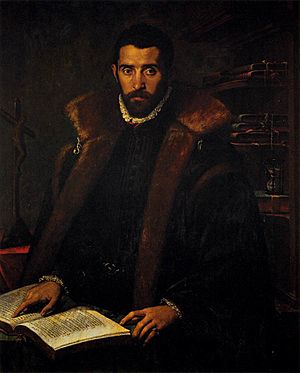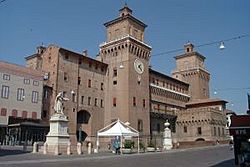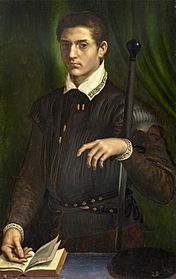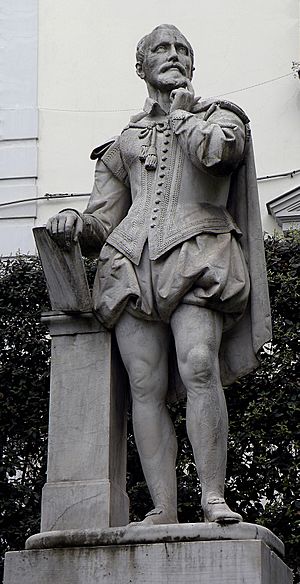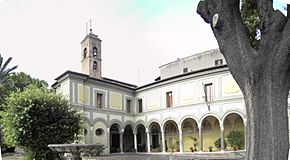Torquato Tasso facts for kids
Quick facts for kids
Torquato Tasso
|
|
|---|---|
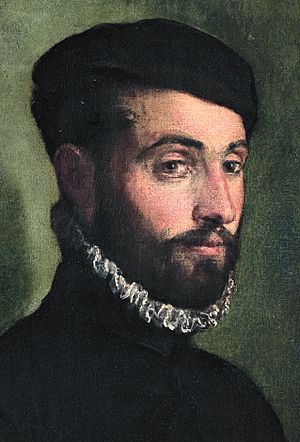
Portrait of Torquato Tasso, aged 22, by Jacopo Bassano.
|
|
| Born | 11 March 1544 Sorrento, Kingdom of Naples |
| Died | 25 April 1595 (aged 51) Rome, Papal States |
| Occupation | Poet |
| Genre | Epic poetry, lyric poetry |
| Signature | |
 |
|
Torquato Tasso (born March 11, 1544 – died April 25, 1595) was a famous Italian poet from the 1500s. He is best known for his long poem, Gerusalemme liberata (which means Jerusalem Delivered). This poem, finished in 1591, tells an exciting and imaginative story about battles between Christians and Muslims during the First Crusade. It focuses on the Siege of Jerusalem in 1099.
Tasso faced challenges with his mental health throughout his life. He passed away just a few days before he was supposed to be crowned as the "king of poets" by Pope Clement VIII on the Capitoline Hill in Rome. His writings were translated into many languages and inspired many other artists. For a long time, until the early 1900s, he was one of the most popular poets in Europe.
Contents
The Life of Torquato Tasso
Early Years and Family
Torquato Tasso was born in Sorrento, Italy. His father, Bernardo Tasso, was a nobleman and a well-known poet. His mother, Porzia de Rossi, came from an important family in Naples. For many years, Torquato's father worked for a prince named Ferrante Sanseverino.
When Torquato was a child, the prince got into trouble with the Spanish government in Naples. As a result, Torquato's father lost his job and his land. Torquato and his father were even declared rebels. In 1552, young Torquato lived with his mother and sister in Naples. He went to a school run by the Jesuits and was known for being very smart and religious, even at a young age.
Later, Torquato joined his father in Rome, where they lived in poverty. In 1556, his mother died suddenly in Naples. His father believed she had been poisoned. Torquato never received his mother's inheritance.
Growing Up in Urbino
In 1557, Torquato's father found a new job at the court of Urbino. This was a much better situation. Young Torquato, who was handsome and clever, became a friend and study partner to Francesco Maria II della Rovere, the son of the Duke of Urbino.
Urbino was a place where many educated people enjoyed art and literature. Torquato's father would read parts of his own long poem, L'Amadigi, to the duchess. He also discussed famous poets like Homer and Virgil. Torquato grew up in a fancy and scholarly environment, which shaped his personality and writing style.
Studies and First Epic Poem
In Venice, Torquato's father oversaw the printing of his poem Amadigi in 1560. Torquato became popular among a group of writers. However, his father wanted him to have a more stable job, so he sent Torquato to Padua to study law.
But Torquato was more interested in philosophy and poetry. By 1562, he had already written his own 12-part epic poem called Rinaldo. This poem tried to mix the strict rules of classical epics with the exciting stories of romantic ones. Rinaldo showed that Tasso was a very original writer, even though some parts seemed unfinished. Everyone saw him as the most promising young poet of his time. His proud father allowed the poem to be printed.
After studying briefly in Bologna, Tasso began working for Cardinal Luigi d'Este. He had already visited the Este court in Ferrara and had fallen in love with Lucrezia Bendidio, one of the duchess's ladies-in-waiting. She inspired many of his early love poems.
Life at Ferrara Court
From 1565, Tasso spent most of his time at the castle in Ferrara. These next five years were some of the happiest of his life, even though his father died in 1569, which made him very sad. Tasso was young, good-looking, and skilled in everything a gentleman should know. He was already famous for his poems and writings. He became very popular at the most brilliant court in Italy.
The princesses Lucrezia and Eleonora d'Este were unmarried and about ten years older than him. They took him under their wing and treated him like family. In 1570, he traveled to Paris with the cardinal.
Tasso was very honest and sometimes lacked tact, which led to a disagreement with the cardinal. The next year, he left France and started working for Alfonso II d'Este, Duke of Ferrara, the cardinal's brother.
Masterpieces: Aminta and Gerusalemme Liberata
The most important things Tasso did between 1571 and 1574 were finishing Aminta in 1573 and Gerusalemme Liberata in 1574.
Aminta is a simple play about shepherds and country life, but it has a beautiful, musical quality. It came out when music was becoming very important in Italy. The sweet and emotional style of Aminta perfectly captured the mood of the time. It influenced operas and songs for two centuries. Aminta was first printed in Venice in 1581.
Gerusalemme Liberata is a much bigger and more important work in European literature. Tasso wanted to make Italian epic poems better by keeping the story focused and using elevated language. He chose Virgil as his guide and the first crusade as his topic. He filled the poem with religious passion, especially in the character of the hero, Godfrey.
However, Tasso's natural talent was for romantic stories. So, he added many exciting and romantic parts to Gerusalemme Liberata. While Godfrey of Bouillon is the main hero, readers are often more drawn to characters like Ruggiero, Rinaldo, and Tancredi, and even the brave Saracens they fight and fall in love with.
The poem includes three main stories about noble pagan women and the Crusaders. Armida, a beautiful sorceress, tries to cause trouble in the Christian camp but ends up converting to Christianity because of her love for a knight. Clorinda, a brave female warrior, fights a duel with her devoted lover and is baptized by him as she dies. Erminia, who is secretly in love with Tancredi, finds safety in a shepherd's hut.
These stories are what truly capture the reader's attention, more so than the battles or religious events. Tasso's great skill was in creating poetry that explored deep feelings and emotions. This was new in the 1500s and fit well with the growing appreciation for women and the rise of music. This refined, noble, and sometimes sad emotion runs through Gerusalemme Liberata. It is found in the beautiful rhythm of his verses and brings to life the heroines whose names were known across Europe for centuries.
Challenges and Mental Health
Tasso finished his epic poem when he was 31. After this, his life became much harder. Instead of publishing Gerusalemme as he wanted, he became overly worried and sent the poem to a group of famous writers for their opinions.
Each of these friends praised the poem but also found fault with it. Some wanted it to be more classical, others wanted more romance. Some worried about religious issues, while others wanted him to remove the most charming parts, like the love stories. Tasso had to defend his work against all these different opinions.
These critics didn't understand what the public later loved about the poem. They felt there was a great romantic poem hidden inside a less perfect epic. They suggested many changes, but the best advice would have been to just publish it as it was.
Tasso was already tired from his studies, court life, and writing. Now, the constant worry made him feel almost unwell. His health got worse. He complained of headaches and fevers and wanted to leave Ferrara. The Gerusalemme manuscript was put aside. He tried to find work with the court of Florence, which made the Duke of Ferrara angry. Duke Alfonso didn't like his famous courtiers leaving him for other rulers. Also, Alfonso was worried about upsetting powerful religious groups in Italy.
Alfonso also thought that if Tasso left, the Medici family in Florence would get the dedication of his famous epic. So, he put up with Tasso's moods and tried to keep him in Ferrara. From 1575 to 1577, Tasso's health continued to decline.
Other courtiers became jealous and tried to insult him. Tasso was easily annoyed and suspicious, which made him an easy target. During the 1570s, Tasso began to feel like people were trying to harm him. He thought his servants were betraying him and that he might be poisoned. These feelings led to stories about him being restless and misunderstood.
In 1577, he even pulled a knife on a servant in front of Lucrezia d'Este. He was arrested, but the duke released him and sent him to his country home for a change of scenery. From there, Tasso went to a Franciscan monastery in Ferrara to focus on his health. But he became convinced the duke wanted to kill him. He escaped in July, dressed as a peasant, and walked to his sister's home in Sorrento.
It seems that after 1575, Tasso developed a mental illness that made him difficult to be around. There is no proof for the later romantic idea that this was caused by a love for Leonora. The duke, though strict, was actually quite patient with Tasso. He was not the cruel monster some later stories made him out to be.
While with his sister, Tasso missed Ferrara. He wrote to the duke, asking to be taken back. Alfonso agreed, but only if Tasso would get medical treatment for his sadness. Tasso gladly returned and was welcomed by the duke's family. However, his old problems soon returned, leading to more arguments, moodiness, and outbursts.
Time in St. Anna Hospital
In the summer of 1578, Tasso ran away again. He traveled through many cities, including Mantua, Padua, Venice, and Urbino. In September, he arrived in Turin on foot and was kindly welcomed by the Duke of Savoy. Wherever he went, people honored him because of his fame. Important people opened their homes to him, out of both pity and admiration. But he soon grew tired of their company and wore out their kindness with his complaints.
It seemed he couldn't live happily outside Ferrara. So, he again spoke with the duke, and in February 1579, he returned to the castle.
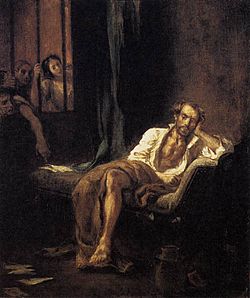
Duke Alfonso was about to get married for the third time. He had no children, and if he didn't have an heir, his state might fall under the control of the Holy See. So, the wedding celebrations were not a time of great joy for the duke.
Tasso, focused on his own problems, didn't consider the duke's worries. He felt he had been given rooms that were not good enough for him. The duke was busy. Without waiting, Tasso started yelling and acting strangely. He was then sent to the hospital of St. Anna, which was a place for people with mental illness. This happened in March 1579, and he stayed there until July 1586. Duke Alfonso believed Tasso was unwell and that St. Anna was the safest place for him.
After the first few months, Tasso had large rooms, received visitors, and was allowed to go out with trusted friends. He could also write letters freely. His letters from St. Anna are a valuable source of information about his condition and personality. It's interesting that he always spoke respectfully of the duke. Some people thought he was just pretending to be respectful to get out, but his letters show he truly believed he had a serious mental illness and was aware of it.
While in St. Anna, he spent his time writing many philosophical and ethical dialogues. He mostly stopped writing poetry, except for occasional poems about his suffering. In 1580, he heard that parts of Gerusalemme were being published without his permission. The next year, the whole poem was published, and seven editions came out in six months.
Tasso, still in St. Anna, had no control over his publishers. He never earned any money from his masterpiece, which placed him among the greatest poets like Petrarch and Ariosto. In 1582, another poet at the Ferrara court, Giovanni Battista Guarini, edited and published Tasso's love poems without his input.
A few years later, in 1585, two scholars from the Crusca Academy criticized Gerusalemme. They insulted it, but Tasso replied with politeness and calm, showing he was still very capable of clear thought. He was troubled by his circumstances and his time, but he was not without his noble qualities. He behaved with dignity in the hospital.
Even in his illness, Tasso tried to help his two nephews, his sister Cornelia's sons, find jobs at court.
Later Years and Final Days
In 1586, Tasso left St. Anna because Vincenzo Gonzaga, the Prince of Mantua, asked for his release. He went to Mantua, enjoyed freedom and court life for a while, and was warmly welcomed in his hometown of Bergamo. He also rewrote his 1573 play Galealto Re di Norvegia into a classical drama called Torrismondo. But after only a few months, he became unhappy again. Vincenzo Gonzaga became Duke of Mantua and had little time for the poet. Tasso felt ignored.
In 1587, he traveled to Rome and stayed with an old friend, Scipione Gonzaga, who was now a high-ranking church official. The next year, he went to Naples and wrote several religious poems. In 1589, he returned to Rome and stayed with his friend again, but the servants found him difficult and he had to leave. He fell ill and went to a hospital. His friend took him in again in 1590, but Tasso's restless spirit drove him to Florence.
His last years, from 1590 to 1594, were a tiring journey between Rome, Naples, Florence, and Mantua. He faced illness, poverty, and bad luck. He was always welcome in the homes of princes, cardinals, and even popes, but he could never settle down.
His health grew weaker, and his writing talent seemed to fade. In 1592, he published a changed version of Gerusalemme, called Gerusalemme Conquistata. He removed all the charming parts from his earlier poem. The verses became more formal, and the romantic and magical parts were taken out. In the same year, he published a poem about the book of Genesis, called Le Sette Giornate.
When it seemed Tasso was being forgotten due to his mental health issues, physical weakness, and fading inspiration, his last years brought new hope. Pope Clement VIII became pope in 1592. He and his nephew, Cardinal Aldobrandini, decided to help the poet. In 1594, they invited him to Rome. There, he was to receive the crown of laurels, just like Petrarch had been crowned, on the Capitol.
Tasso, worn out by illness, arrived in Rome in November. The crowning ceremony was delayed because Cardinal Aldobrandini fell ill. But the pope gave him a pension, and a prince who held Tasso's mother's estate agreed to pay him a yearly income.
It seemed fortune was finally smiling on Tasso. He was about to receive great honors and money. But it was too late. Before he could wear the crown or receive his pensions, he went to the convent of Sant'Onofrio on April 1, 1595. The monks saw a cardinal's carriage coming up the hill and came to greet it. Tasso stepped out and told the prior he had come to die there.
Tasso died in Sant'Onofrio in April 1595, at the age of 51. The last twenty years of his life had been difficult and artistically unfulfilling.
Other Writings
- Rime (Rhymes): Tasso wrote almost two thousand lyric poems between 1567 and 1593. These were influenced by Petrarch's Canzoniere (Songbook).
- Galealto re di Norvegia (1573–74): This was an unfinished tragedy that he later completed under a new title, Re Torrismondo (1587). It was influenced by ancient Greek and Roman tragedies and tells the story of Princess Alvida of Norway.
- Dialoghi (Dialogues): Written between 1578 and 1594, these 28 texts discuss topics from good behavior (like love, virtue, and nobility) to everyday things (like masks, games, and courtly style). Tasso also touched on big ideas of his time, such as religion versus freedom of thought.
- Discorsi del poema eroico (Discourses on the Heroic Poem): Published in 1594, this is Tasso's main work about how epic poetry should be written. He probably wrote it while he was working on Gerusalemme Liberata.
Mental Health
Today, it is believed that Tasso's illness was bipolarity, a condition that affects mood. Stories describe him wandering the streets, feeling like he was being watched or harmed. After his long stay in the Santa Anna hospital in Ferrara, he was able to write again, but he never fully recovered.
Influence on Others
Tasso's work had a big impact on many artists and writers:
- His lyric poetry may have influenced French poets like Desportes and Ronsard. It also likely influenced English writers like Sir Philip Sidney.
- Composers like Claudio Monteverdi set parts of Gerusalemme Liberata to music. Many other composers, including Giaches de Wert and Carlo Gesualdo, also used Tasso's poems for their music.
- The German writer Johann Wolfgang von Goethe wrote a play called Torquato Tasso in 1790. This play explores the challenges faced by artists.
- Giacomo Leopardi wrote a prose piece called Dialogo di Torquato Tasso e del suo Genio familiare (1824), which is about Tasso's long stay in St. Anna.
- Many operas have been based on Jerusalem Delivered, by famous composers like Lully, Vivaldi, Handel, and Rossini.
- Both Edmund Spenser and John Milton were greatly influenced by Tasso's work.
- Lord Byron's poem "The Lament of Tasso" tells the story of Tasso's time in St. Anna's hospital.
- The Italian composer Gaetano Donizetti wrote an opera about Torquato Tasso in 1833.
- Franz Liszt composed a musical piece called Tasso, Lamento e Trionfo to honor Goethe's birth.
- Many famous artists, including Tintoretto, Poussin, and Delacroix, were inspired by Jerusalem Delivered and Aminta.
English Translations
During the Renaissance, the first (though incomplete) English translation of Jerusalem Delivered was done by Richard Carew in 1594. A full version by Edward Fairfax came out in 1600. Later versions were done by John Hoole (1772) and Jeremiah Holmes Wiffen (1821). More recent translations include those by Anthony Esolen (2000) and Max Wickert (2009). Tasso's play Aminta and some of his early love poems have also been translated into English.
Legacy
Tasso is remembered with monuments in Bergamo and Sorrento. Many major Italian cities, like Bergamo, Naples, Rome, and Turin, have streets named after him. There are also streets named after him in Paris and Palo Alto, California.
See also
 In Spanish: Torquato Tasso para niños
In Spanish: Torquato Tasso para niños
- Ludovico Ariosto
- Orlando Furioso


